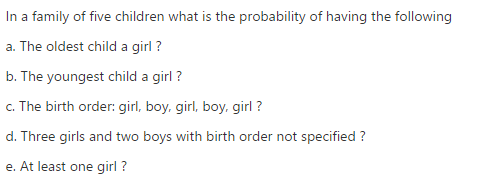Probabilities?

1 Answer
See below:
Explanation:
a
Gender is a 50/50 thing, and so the probability of the oldest child being a girl is
b
With no further information about the family, the same gender probability holds here.
c
There is a
d
This is a binomial probability - we're being asked to look at all the different ways we can have gender choices in 5 children - from 5 boys to 5 girls and every mix in between.
That general form looks like:
What we're interested in is where 5 children,
e
To see what the probability of having at least one girl is, we can take the full set of possibilities (5 girls to 5 boys and everything in between) and subtract out the probability of having 5 boys (all the other possibilities will have at least 1 girl).
We can use the binomial probability again with
And so the probability of having at least one girl is:

